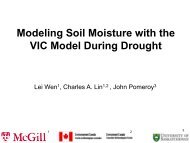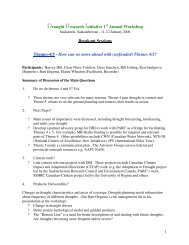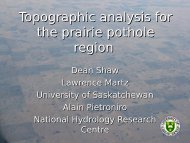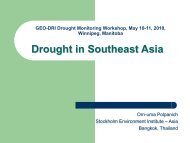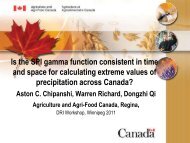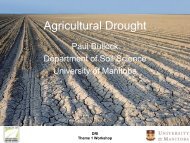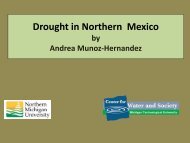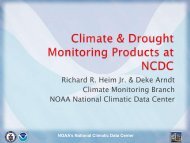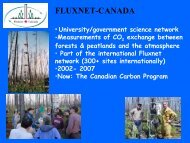Ted Harms.pdf
Ted Harms.pdf
Ted Harms.pdf
You also want an ePaper? Increase the reach of your titles
YUMPU automatically turns print PDFs into web optimized ePapers that Google loves.
Soil Moisture Monitoring<br />
for Irrigation Scheduling<br />
T.E. <strong>Harms</strong> Irrigation Management<br />
AAF, Brooks AB.
Soil Moisture Instrument<br />
Evaluation<br />
• 4 year study that is still continuing<br />
informally.<br />
• Criteria for Soil Moisture Instruments<br />
• Cost Effective (~$1000 Cdn)<br />
• Portable<br />
• Reasonable Accuracy<br />
• Easily Understood Visual Display<br />
• Immediate Display<br />
• No Special Training
COMPARISON OF VARIOUS<br />
MODES OF PROBE<br />
INSTALLATION FOR PROFILING<br />
Soil<br />
Auger<br />
Moisture•Point<br />
C Probe<br />
PF-1<br />
Single segment<br />
TDR and<br />
Capacitance<br />
Access Tube<br />
Probes<br />
TDR and Capacitance<br />
Forks and Buried Type<br />
Probes,<br />
Gypsum Blocks<br />
Neutron Probe for<br />
Access Tube, RF<br />
Sensor<br />
Gravimetric<br />
Method
Soil Moisture Instruments<br />
Evaluated for Irrigation Scheduling
Pros and Cons<br />
• Pros and cons with all sensors<br />
• CPN 503 DR is the standard but its storage,<br />
use, certification is strictly regulated.<br />
• Capacitance sensors are sensitive to soil<br />
salinity and change based on soil bulk<br />
density.<br />
• Soil potential probes have limited range up to<br />
–200<br />
cbars.<br />
• They all work and the choice depends on the<br />
application desired.
RomComm Kelowna<br />
Brooks<br />
Soil Moisture Sensor, Pivot<br />
in Lethbridge, AB
120<br />
Available Water Content (%)<br />
100<br />
80<br />
60<br />
40<br />
Turn Pivot Off<br />
Turn Pivot On<br />
20<br />
0<br />
10-May 20-May 30-May 9-Jun 19-Jun 21-Jul 31-Jul 10-Aug<br />
Date
Zimmatic’s New GrowSmart<br />
Technology
Irrigation Strategies<br />
1 week<br />
Root zone full<br />
0-15”<br />
20”<br />
Allowable depletion<br />
30”
Limited Adoption of Soil Moisture<br />
Sensors for Irrigation Scheduling<br />
• Expense is not worth the information provided.<br />
• Too complicated - installation, learning curve for<br />
use, interpretation.<br />
• Effort is not worth the result.<br />
• Point measurement in field.<br />
• Time consuming.<br />
• No local support.<br />
• Interest and use primarily by consultants and<br />
industry field personnel.
ET Based Irrigation Scheduling<br />
• Alberta Irrigation Management Model<br />
(AIMM)<br />
• Desktop<br />
• Irrigation Management Climate Information<br />
Network (IMCIN)<br />
• Web-based<br />
based
Advantages<br />
• Many irrigators are farming increased area and are<br />
not as “intimate” with individual fields.<br />
• Daily information regarding the soil moisture status<br />
of your fields.<br />
• Can prioritize time to concentrate on the fields<br />
requiring irrigation.<br />
• Anticipate irrigation need rather than react to soil<br />
moisture shortage or crop stress.<br />
• Assists decision making for efficient and effective<br />
irrigation scheduling.
Information can be provided as:<br />
• Pull – require user to request information (How<br />
most automated pivot systems work – how IMCIN<br />
works).<br />
• Push – deliver information to the user (Increasing in<br />
use with consultants, producer groups – most<br />
attractive option for irrigators).<br />
• Plug – allow user to maintain hands-on contact with<br />
data source (AIMM – desktop application).<br />
(Magarey<br />
et al., 2002)
Example of Graphical Output from<br />
AIMM
Example of Information from<br />
IMCIN Website
Conclusions<br />
• Soil moisture sensors for irrigation scheduling –<br />
limited adoption in Southern Alberta.<br />
• Advanced features supplied by pivot manufacturers<br />
for continuous soil moisture measurement and<br />
information – no adoption that presenter aware of<br />
in Southern Alberta.<br />
• ET based scheduling tools – estimated about 15% of<br />
irrigated area in Southern Alberta using AIMM for<br />
irrigation scheduling.<br />
• IMCIN increasing in utility and use – developing<br />
disease forecasting and urban watering.



